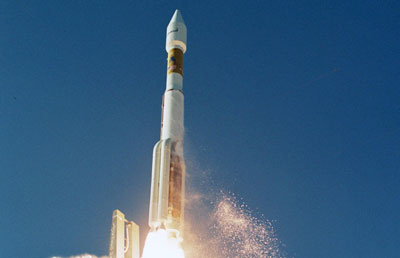Can NASA keep its side of the trans-Potomac bargain?by Taylor Dinerman
|
| From the DoD perspective the problem is that they need NASA to make a solid commitment to the EELV, while the agency wants to continue to buy launch services on a competitive basis. |
NASA’s Science Mission Directorate seems happy to transfer most of its future missions from the Delta 2 to the EELVs. The greater payload and fuel supplies that can be boosted into orbit on the larger rockets means that they will be getting a bit more “bang for the buck” in spite of the higher price per launch. The Delta 2 was a wonderful launch vehicle but as Lori Garver, former NASA plans and policy director, once put it, “…it’s time to put away one set of toys and bring out another set.”
From the DoD perspective the problem is that they need NASA to make a solid commitment to the EELV, while the agency wants to continue to buy launch services on a competitive basis, the way its been done for the last couple of decades. To put it another way, the Pentagon has an obligation to maintain secure access to space as a national priority, and this means that at least two viable launch systems must be available so that if one has to be put into hibernation after a launch failure the US will still have at least one way to get its military payloads into orbit. NASA has no such industrial policy requirement.
NASA’s normal procedure is to ask launch providers to compete for contracts. Theoretically, this provides the agency with the lowest cost rides into orbit. In fact, NASA has been happily using the Delta 2 as a general workhorse for years. Less versatile rockets such as Orbital’s Pegasus and Taurus have had to content themselves with the crumbs. The SpaceX Falcon series may end up the same way, if they fail to meet their ambitious low-cost goals.
The need to send US supply payloads to the International Space Station is going to change the nature of NASA’s requirements. NASA will have to do this in conjunction with Russia’s Progress, ESA’s ATV and the Japanese HTV supply craft. Instead of a few launches dedicated to science, carried out at irregular intervals, there will be a need for a delivery system that launches at regular intervals to the same orbital position. This will allow for long-term planning and, with the right organization, should establish a useful operational rhythm, similar to the successful way the Russians operate the Soyuz and Progress.
| Keeping the EELV assembly lines open and relatively healthy is, for the foreseeable future, a national security imperative. Anything NASA does that helps accomplish that objective is a positive contribution by the agency to overall strength of this nation, and the reverse is also true. |
If this were to be done by either Atlas 5s or Delta 4s it would solve many of the Defense Department’s problems with the EELV program. According to sources, both of these programs need to make at least four cores a year, at a minimum, to stay in business. A NASA contract to fly supplies to the ISS four times a year would put one of these rockets, say, the Delta 4, on a solid and profitable footing. This would leave the other to pick up enough DoD and NASA science missions, as well as the occasional commercial contract, to stay alive.
Since there are a finite number of shuttle missions left, and whatever that number it seems that NASA will not be able to get all the ISS parts up on that US spacecraft, the case for launching some elements of the ISS on EELVs seems a good one. However, since these items, such as the Japanese Kibo Laboratory, were designed to be carried in the orbiter’s cargo bay, it may be that there will be few, if any, parts that could be carried up that way. Since the US does have at least a moral obligation to try and finish the station to the maximum extent possible, NASA should be ready to spend time and money to see if the EELVs can be modified for this role.
One other potential problem is that the assembly choreography depends partly on the use of the shuttle’s robot arm. Without it, the station’s own remote manipulation system might not have the ability to install new elements delivered by the EELVs. A possible solution may exist, if station modules could be launched while the shuttle is docked to the station. The new electrical hardware designed to allow the orbiter to draw power from the station and thus remain docked to the ISS for longer periods may allow this to happen. However, the EELV in question would have to be launched in a very tight window and that may be very difficult indeed.
Most importantly NASA should understand that it is above all an American institution and that as an organization, it has a primary obligation to support US national interests. Keeping the EELV assembly lines open and relatively healthy is, for the foreseeable future, a national security imperative. Anything NASA does that helps accomplish that objective is a positive contribution by the agency to overall strength of this nation, and the reverse is also true. The agreement between Griffin and Sega was a very good deal for NASA; it would be foolish for them to call it into question simply in order for NASA to keep doing things according to past procedures.
